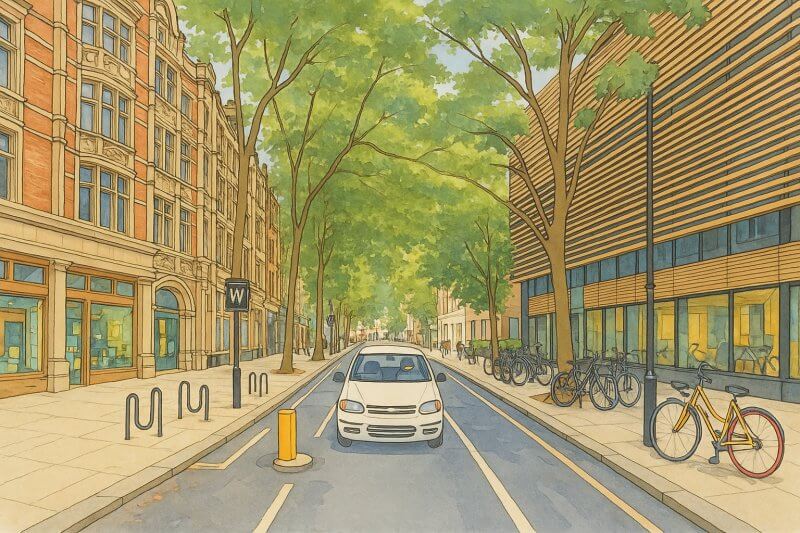
Fitzrovia, London
Fitzrovia: The Heart of Historic and Creative London
A Neighbourhood with History, Character, and Creativity
Located in central London, Fitzrovia is a vibrant and eclectic area nestled between Marylebone and Bloomsbury to the west and east, and Soho to the south.Fitzrovia lies within both the City of Westminster and the London Borough of Camden, positioning it perfectly between some of London’s most iconic areas.
It is often described as both bohemian and elegant, a place where creative energy meets historical charm, making it a fascinating part of the capital for locals and visitors alike.
Size and Population of Fitzrovia
Fitzrovia covers a relatively compact area, roughly 0.28 square miles (0.73 square kilometres).Despite its modest size, it has a vibrant and active community, with an estimated population of around 8,000 residents as of 2024.
The area's central location, diverse housing, and proximity to major London institutions make it one of the most desirable and dynamic neighbourhoods in the city.
Map of Fitzrovia, London
Major Roads in Fitzrovia
Several major roads define and run through Fitzrovia, making it well connected and easy to navigate.Key roads in Fitzrovia include:
- Oxford Street: Forming the southern boundary, it is one of the most famous shopping streets in the world.
- Tottenham Court Road: Running along the eastern edge, this road is renowned for its electronics shops and tech stores.
- Great Portland Street: Cutting through the area from north to south, Great Portland Street is a major thoroughfare lined with shops and offices.
- Charlotte Street: A lively street famous for its restaurants, cafés, and creative businesses.
- Goodge Street and Cleveland Street: These are important local roads lined with historic buildings and residential properties.
The History of Fitzrovia
Fitzrovia developed gradually during the 18th and early 19th centuries, originally consisting of elegant townhouses for London's burgeoning middle class.The name "Fitzrovia" began to be used informally in the 1930s and 1940s, popularised by artists, writers, and bohemians who frequented the Fitzroy Tavern on Charlotte Street.
Although the name was initially informal, it gained widespread usage over the decades and is now the accepted name for the area.
In the past, Fitzrovia was known for its artistic and intellectual residents, including writers like George Orwell and Virginia Woolf, adding to its enduring cultural cachet.
Demographics of Fitzrovia
Today, Fitzrovia's demographics reflect a rich blend of ages, professions, and backgrounds.The area is home to:
- Young professionals who appreciate its central location and vibrant atmosphere.
- Families drawn to its relatively quiet streets and proximity to good schools and parks.
- Students attending nearby University College London (UCL) and other institutions.
- Long-time residents who maintain the sense of community that Fitzrovia is known for.
Real Estate Prices in Fitzrovia
As of early 2025, Fitzrovia’s real estate prices are among the higher ranges compared to many parts of London, reflecting its desirability and prime location.The average property price in Fitzrovia is approximately £1.7 million for a two-bedroom flat of between 800 to 1,100 square feet (75 to 100 sq metres), whereas the overall average for London sits around £730,000. In more luxurious spots of Fitzrovia such as Charlotte Street or Fitzroy Square, £1.7 million wil get you a smaller space, more like 750 to 850 square feet, but finished to a very high specification.
Rental prices are also high, with one-bedroom flats typically ranging from £2,500 to £3,500 per month depending on condition and exact location.
While expensive, Fitzrovia remains slightly more affordable than some of its immediate neighbours like Mayfair and Marylebone, offering an appealing balance of prestige and value.
Important Buildings and Landmarks in Fitzrovia
Fitzrovia boasts an impressive selection of historic and modern landmarks, including:- BT Tower: One of London’s most recognisable structures, originally built as the Post Office Tower in the 1960s.
- Fitzroy Tavern: A historic pub on Charlotte Street, famous for its literary and artistic clientele.
- All Souls Church, Langham Place: A stunning 19th-century church designed by architect John Nash.
- University College Hospital: A major teaching hospital located along Euston Road.
- Pollock’s Toy Museum: A quirky museum dedicated to traditional toys and toy theatres, housed in two historic buildings on Whitfield Street.

Painting of Fitzrovia (View full-size image here)
The Characteristics of Fitzrovia
Fitzrovia is known for its unique blend of characteristics, combining elements of:- Historic charm: Georgian and Victorian architecture line many of its streets.
- Creative energy: A long-standing hub for media, advertising, and design businesses.
- Urban village feel: Despite its central location, Fitzrovia has a residential, community-focused atmosphere.
- Diverse dining: A fantastic range of independent cafés, fine dining restaurants, and historic pubs.
- Green spaces: Small parks and squares like Fitzroy Square and Crabtree Fields offer a breath of fresh air.
Nearest London Underground Stations
Fitzrovia is extremely well served by public transport, with several Underground stations within easy walking distance:- Goodge Street Station: Served by the Northern Line.
- Warren Street Station: Served by the Northern and Victoria Lines.
- Tottenham Court Road Station: Served by the Central, Northern, and Elizabeth Lines.
- Oxford Circus Station: Served by the Bakerloo, Central, and Victoria Lines.
- Great Portland Street Station: Served by the Circle, Hammersmith & City, and Metropolitan Lines.
Fun Fact About Fitzrovia
One particularly fun fact about Fitzrovia is that the BT Tower, once the tallest building in London, was officially a state secret!For many years, its existence was not officially acknowledged, and it did not even appear on official maps despite being visible from miles around.
Today, the BT Tower remains an iconic symbol of London’s skyline and a quirky part of Fitzrovia’s legacy.